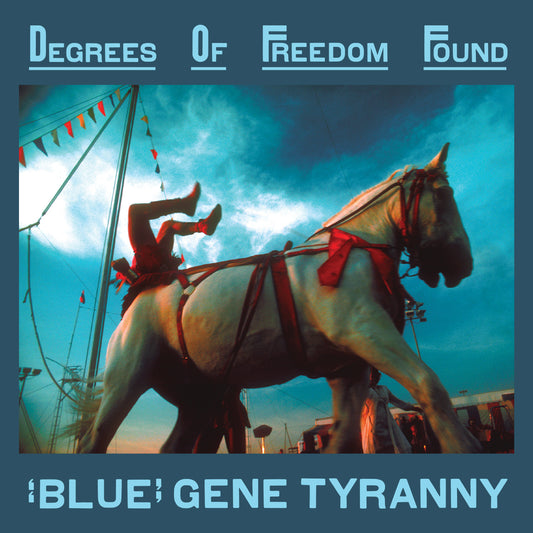Trust in Rock is a recording of the final night of a concert given November 4-6, 1976, in Gallery A of the University Art Museum in Berkeley, California, featuring composer-performers “Blue” Gene Tyranny (Robert Sheff) on piano and synthesizer, and Peter Gordon on tenor sax.
Trust in Rock was Gordon’s media-satiric name for it, though it wasn’t exactly what most people thought of as “rock” at the time. The very use of the word was startling, though; even as rock dominated the music business, it was pretty much taboo in even the hippest college composition classes at the time, even those specializing in the intentionally vague label of “new music.” Gordon, who was 25 at the time, had bailed on academia and was hanging with Arthur Russell and Rhys Chatham in New York, while Tyranny, 31, had left Iggy Pop’s band three years previously. The East Village / SoHo scene was in its early stages, as was punk.
A pre-concert blurb in Ear magazine called it NEW MUSIC FOR ROCK BAND. Trust in Rock stands out as an early example of composers forming ensembles configured like rock bands, exploring structural ideas with the by-then-standard rock instrumentation of keyboard, guitar, bass, and drum, plus the occasional horn section. The already established wave of “minimalist” composers (Philip Glass et al) didn’t do this. Gordon would follow up in 1977 with the creation of Love of Life Orchestra, or LOLO, which fluctuated from being a duo to a large ensemble, depending on the occasion, with highly variable instrumentation.
Disclosure: This writer has known the two principals since the early ‘70s, having gone to graduate school with Peter Gordon at UC San Diego in 1972-73; he then went up to study at Mills, where Tyranny was a faculty member. I wasn’t present for Trust in Rock, though; I too was living in New York by then. New in town and in need of work, I filled in for Peter at his graveyard-shift tape-editing job while he went out to California to put Trust in Rock together. I’ve been in the studio and on stage with both of them many times.
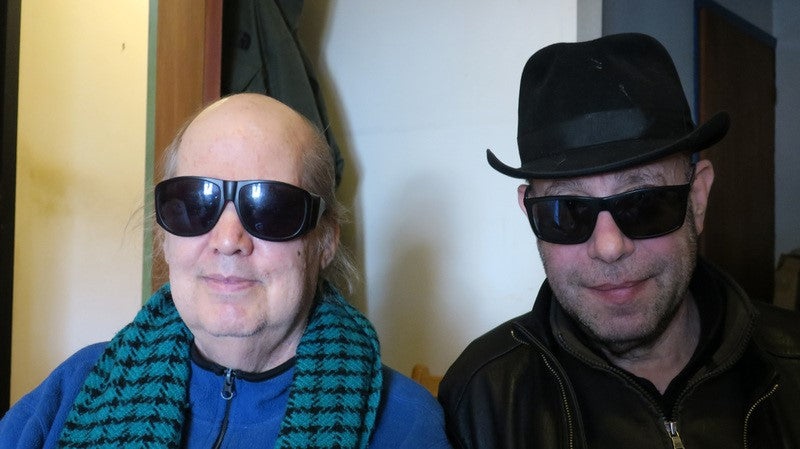
“Blue” Gene Tyranny, left; Peter Gordon, right. Photo: Ned Sublette
42 years after Trust in Rock, we got together in February 2018 to talk about it at Blue Gene’s apartment in Queens. 72 years old and blind, Blue continues to compose, perform, and record. Peter, 66, continues to compose, perform and release new work, and is Professor of Music at Bloomfield College in New Jersey.
What follows is a transcript of our conversation . . .
* * *
NS: What background were you bringing to this music?
BGT: Oh my God. My total background? I’m writing about it now -- writing my autobiography, basically, but it’s in the form of music lessons. It’s done by decades, and I go through my early background, which was experimental music, and music without notes, which is verbal instructions for music, by everybody you can think of. Phil Krumm and I did a lot of that work in the Southwest, in Texas, with other artists -- some were painters, some were poets, some more musicians. And we performed at all sorts of venues. But we were kids. I was 12 or 13 at the time. Phil introduced me to lots of people, and we began writing to John Cage, a lot of the New York composers, and a great many of the so-called Fluxus people.
But at the same time I was playing in rock ‘n’ roll bands in San Antonio, at the drive-in theaters, where you’d stand on top of the concession stand, and underneath were all these 1950s leather types.
PG: Do you remember any of the movies that they were playing?
BGT: Oh yeah. The first movie I remember that was extremely important was Forbidden Planet, with its electronic score by Louis and Bebe Barron. I was a child then, and in front of the screen, underneath it, they had situated a playground with swings and stuff like that, so I was sitting on the swing and watching Forbidden Planet.
NS: And then you went and played rock ‘n’ roll at intermission, for the snack bar break?
BGT: Not at that time, but yes, later, at intermission we would play rock ‘n’ roll, and battle of the bands.
NS: Covers?
BGT: Some covers, some original. Some we didn’t know what they were, we just started playing (laughs).
NS: I remember you telling me about seeing Bob Wills and his Texas Playboys.
BGT: Yes, I did, in a dance hall outside of San Antonio. I was a little kid then, about six or seven years old. I didn’t know who he was, but I remember the name, and I remember dancing around in front of the stage. I remember they had a wooden outline of a cat, and it was called the kitty, if you requested a tune you put money into the kitty.

Clockwise: “Blue” Gene Tyranny, Karl Young, Peter Gordon. Photo: Pat Kelley
NS: So you were bringing a background that encompasses both the vernacular culture of this place you grew up in, and a conceptual framework that was not that.
BGT: Yeah. I’m an air person, I’m a mental person, astrologically. And that motivates me – I mean, I’m a very emotional person too, but that’s another thing. Yeah, the combination of influences – I was born in 1945. It was the start of when rhythm and blues was being generated out of swing at the time, and they started getting a New Orleans thumpa thumpa, and putting a Fats Domino beat to it. I heard a lot of Tex-Mex music in San Antonio, and there was a lot of gospel music, which I would hear mostly on the radio at one or two in the morning. I’d take the radio to bed and hide it so my parents couldn’t hear it. They weren’t against it, they just didn’t want me up late. That’s how you got your music. Otherwise it was novelty music and nonsense.
NS: Peter, could you briefly characterize what you brought to Trust in Rock and how that interacted with what Blue Gene brought?
PG: Like Blue, I had a conceptual interest in music as form and structure, sort of this external manifestation of music as idea. At the same time, I was playing in soul bands, and playing rock. I was born a little bit later than Blue Gene, but growing up in Virginia, I listened to a lot of black radio coming out of northern Virginia and Washington DC, as well as in the ’60’s, when I was living in Munich, Germany, English pop. I played a lot of improvised music in the context of the post-bebop players, but I never considered myself playing jazz. Also, I always liked music with funky beats, coming out of, I guess, James Brown, or what Sly Stone was doing. I think I learned most of my harmony from Motown songs. My formal education came more out of the post-serial academic and conceptual scene, but the actual music and harmonic content came more out of Holland-Dozier-Holland and that type of harmonic rhythm. [To Blue Gene]: And you had played with those guys, when you were…
BGT: Yeah, we did some backup for the Four Tops, that was later, in Ann Arbor, Michigan. Ann Arbor’s only a few miles from Detroit, and it was like every week there was a new entry into the diary, so to speak. It was like a living life thing, it wasn’t like music business, it was a whole continuing life that was generated from Detroit. Next week, you get a song here, and the next week you get the comment on that song, and then a comment on that song, and it went on and on and on, you know, but it was like a whole family generating music all the time. A lot of which got national attention and some of which didn’t.
PG: That’s interesting, because skipping ahead to Oakland, and what was happening at Mills at the time, there were a few important things going on. One big thing was that there was a multitrack recording studio there. But there was also the weekly performance series, and there was that sense of music as being part of regular life -- music as news, rather than this special singular event.
BGT: You know, the concerts that we gave every week at the CCM, Center for Contemporary Music – a nonprofit, public access institution – were organized by and a lot of times starred the music of the composers who were there, or composers who were invited by the Ford Foundation or whatever, to give them an opportunity to do exactly what they want to do, and the same thing went for all the people who were students, like Peter. The condition was, anybody could come, but we didn’t invite any critics, so even though we got ridiculously uninformed critics from the local San Franciscan newspapers, I must say, talking about “Robert Sheff and his ilk put on a concert of John Cage and his ilk’s music,” things like that. You didn’t want that spirit, you didn’t need that spirit, because that’s not what you’re working on, you weren’t trying to entertain in that way. I mean, the music was entertaining if you let yourself go, but you had to let yourself go out of these states. Cage’s music would generate in the players absolutely new feelings and systems of thought. [becomes emotional, pause button pushed, resumes]
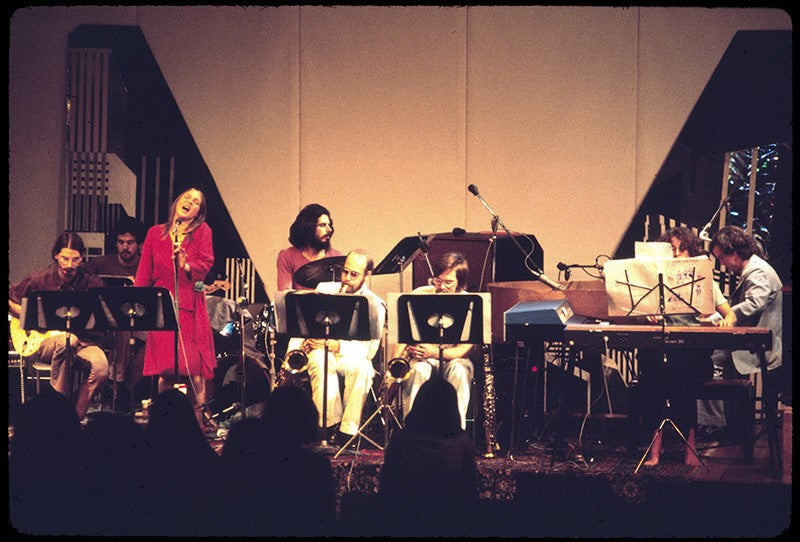
Left to Right: Paul Dresher, Steve Bartek, Patrice Manget, Gene Reffkin, Peter Gordon, Karl Young, Janet Cuniberti, “Blue” Gene Tyranny. Photo: Pat Kelley
NS: Who were these people who played at this concert? What relationship did they have to the music?
BGT: Almost all of the people that played were Mills-associated, but not everybody. Peter, what was the fellow’s name who played sax with you?
PG: Karl Young, who also played flute. I had replaced Karl in a 1950s music revue called Butch Whacks and the Glass Packs. Karl had to quit the band when he began his studies in physics at San Francisco State, and I understand that after a career in physics, he is now devoted to playing the shakuhachi. Then we had composer-guitarist Paul Dresher, who at the time wasn’t going to Mills.
BGT: He was at Berkeley, but he was in a band with me also.
PG: Right, so Paul and Gene Reffkin, the drummer.
BGT: Gene was in the same band.
PG: Yeah, so you and Gene, and when Craig Hazen, one of our original collaborators and bass player, had to drop out due to illness, I called in my old friend Steve Bartek, who I’ve known since high school in LA, still a close friend of mine. While he’s known as a guitarist and flute player (and now one of the leading film orchestrators), he is also quite a fine bass player, an amazing reader, and he was able to jump in at the last minute. Then there was Janet Cuniberti.
BGT: She was a notable student at Mills. I remember she was overjoyed to be part of this collaboration. She was playing synthesizer . . .
PG: . . . .and RMI piano. Two keyboards.
BGT: Patrice Manget, the singer, had a group called Patrice and her Nasty Band with her husband, whose name was Nasty [Robert Alden “Nasty” McMaster], who played guitar. They were very good people. They would do all sorts of music / theater events, a very San Francisco kind of performance esthetic. I played with the Nasty band on a couple of guest appearances. They worked with Ken Beckman, with live video. They were really open to a lot of things.
NS: What about the lyricists?
PG: My songs had lyrics by Kathy Acker, and then Blue Gene wrote his own.
NS: There are two very different kinds of song, two very different kinds of lyrics, in this project. What part do the lyrics play?
BGT: Well, the writers are very different. Kathy was a brilliant poet and lyricist also, and had a truly minimal style that was very elegant. Her lyrics were very much on the surface, but underneath you knew there were all these other depths that you could experience. And mine tended to be more earnest. I’m not really a writer.
We were saying something about American society. Many of Kathy’s stories were about people who were directly confronting their circumstances, without judging them. I unfortunately have a tendency to judge things, and I’m trying to get rid of that now. I think the politics couldn’t be avoided, you know. But mine were more general. There’s one line in one of the songs that says, “I know you care about meaning and money, but will you ever care about me?” “Meaning” is the way people guard themselves with religious meaning or even status in our society, and the idea of money of course is obvious.
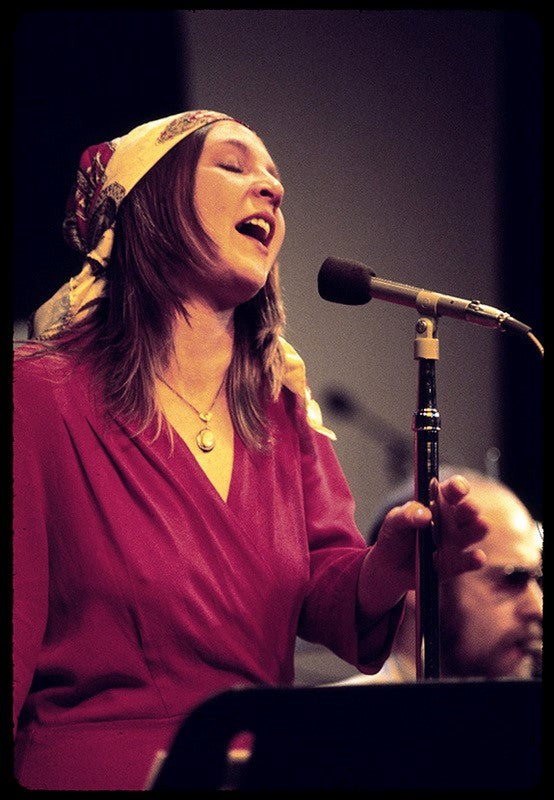
Patrice Manget. Photo: Pat Kelley
PG: One of your lines that I really liked was “Identity, the angels came and took you away.” What do you mean by that?
BGT: The angels are any kind of spirit that solves things for you, or takes you beyond, or gives you a feeling of beyond.
I became blind in 2009 and since then I’ve had profound experiences of what’s called the Charles Bonnet syndrome. It’s a very little-known thing that happens to thousands of people all over the world. Even my doctor never heard of it. She said, “I thought you couldn’t see.” I said, “I can’t see!” Because I’m describing these hallucinations to her. Basically, when you’re awake, or sometimes when you come out of sleeping but usually when you’re awake – and I’ve had this happen for several years now – if you’ve been sighted your whole life and you suddenly become blind in middle age, your brain continues to want that visual stimulus, so it makes its own. So what you see are people, that you don’t know, who are not transparent except if you tried to reach out and touch them. They appear to be maybe just walking through your room. You don’t know who they are, they’re smiling, they’re nice. It’s not frightening at all, except it’s unusual to say the least, especially the first time it happens. Sometimes it’s hallucinations, like a British double-decker bus appearing in your kitchen, things like that. The first person who described this was Charles Bonnet, in 1750, writing from Geneva, in French.
I’m trying now to write a secular cantata. It compares three different ideas about evolution – self propagated, cross-fertilization, and the modern one is transformation. Self-propagation is obvious, and that’s the oldest theory. Then cross-fertilization, of course, is Darwin – and that work was actually done on orchids, not animals. Orchids. He was in love with orchids. And then the modern one, transmutation, is, there was a woman scientist who discovered that if you froze electricity at absolute zero it turns to liquid. I think there’s a certain point when things transmute, and that all phenomena, no matter what it is, is connected. So that’s another idea of evolution, all three of which I think can exist at the same time, it just depends on what you’re talking about, plants or animals or planets or whatever.
Charles Bonnet’s idea was that evolution is progressive – that animals can gain human intelligence, and that humans gradually become angels.
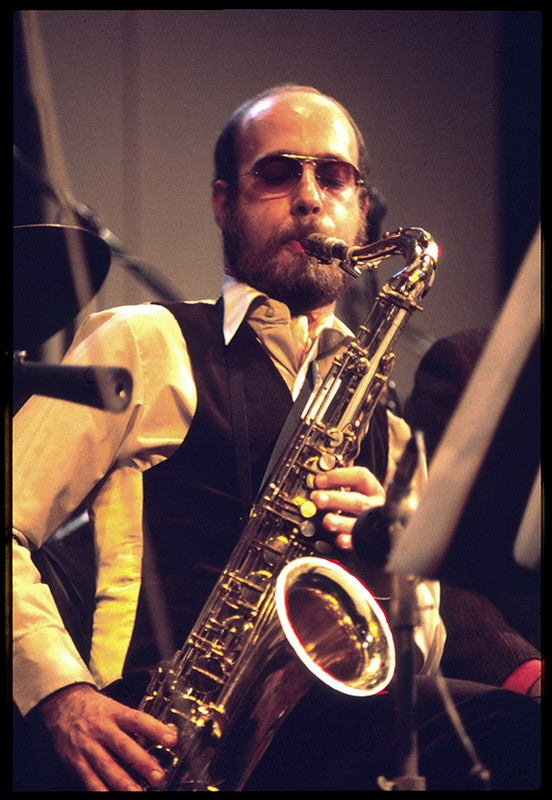
Peter Gordon. Photo: Pat Kelley
NS: “Am I sleeping and waking, or just turning over?”
BGT: That’s “Leading a Double Life.”
NS: Would you mind talking to me a moment about the lyric of that song?
He is in the blue distance
He is getting nearer
She’s in the blue distance
She is getting so clear
I don’t know where they came from
I don’t know how we got here
I just turned my back
And suddenly you were here . . .
BGT: It’s partially about, that we’re all born into a schizophrenic society, and that we live in a schizophrenic way -- which is, there’s an outside reality, there’s an inside reality. And the thing is to get beyond the idea that those are separate. But at the same time to know which is which. When you’re born, you have none of that idea of, you know, the conflict of the universe, of the society in which you’re born, and gradually you learn the language . . . And it’s basically that, leading a double life. If you’re enamored, that’s a beautiful way of leading a double life.
“He is in the blue distance.” Blueness increases with distance. “She’s a visiting wonder.” She or he. The lyrics are gender-interchangeable. It could be a heterosexual or homosexual song, it doesn’t matter, or anything else. “She’s in the blue distance, she’s a dream come true. Am I sleeping or waking or just turning over? A cellular wonder, leading a double life.”
PG: I think Blue’s song suites come from a more personal place, a more introspective place. My songs with Kathy Acker’s lyrics are like three little stories that embody passion, anger, obsession, love, power, rejection. They’re bookended by instrumentals, beginning with “Machomusic,” which is the earliest piece that I still play, from 1973.
NS: I recall the premiere [at UC San Diego.]
PG: You recall the premiere. It builds on this primal cell, the saxophone riff [dahn data dahn data dahn data dahn . . . ]. The original performance included a drone of 16 Buchla synthesizer oscillators tuned in unison . . .
NS: . . . and those oscillators were highly unstable, so part of the piece was how they drifted out of tune over the course of the piece.
PG: . . . and the riff was played in unison by six male saxophonists in drag . . .
NS: . . . hence the title “Machomusic,” but that aspect has not been recreated in subsequent performances of the piece . . .
PG: I guess it was a non-binary exploration of “what it really means to be a man.”. . . and then on the other side, there’s the piece “Intervallic Expansion,” which has to do with both horizontal and vertical expansion and contraction, both melodically and rhythmically, with sections of repeated asymmetrical polyrhythms alternating with sections in straight four.

"Blue" Gene Tyranny. Photo: Pat Kelley
NS: You memorably recorded this piece later in the studio . . .
PG: . . . for Star Jaws, but before that there was a longer tape piece called “If I Trust You,” which began as a song -- actually, I was just listening to it on Seven Years of Crazy Love, which is “Blue” Gene’s mix tape of pieces done at Mills. “Intervallic Expansion” as a live piece came out of a song that is never actually sung within the show: “If I trust you, a revolution will happen.” “Intervallic Expansion” was also the fourth movement of my Symphony #1 at The Kitchen in 1976, which featured Philip Glass on the clavinet.
BGT: Would the title “If I Trust You” have anything to do with Trust in Rock?
PG: Yes, with the optimistic idea that social change can happen. At the same time, I was working as a tape editor making commercial spots at WHN-AM radio in New York. Commercial radio is about slogans and soundbites that are designed to make the listener feel personally invested in whatever product you’re selling, so I thought of the slogan, “Trust in rock, your new concept in music.”
NS: What I see in your instrumental pieces -- “Intervallic Expansion” and “Machomusic” -- is a kind of structuralist concern that was, to my ear, one of the marked characteristics of your work in the years that followed.
PG: I think it was there, though, in the songs as well. It was sort of hung on the framework of the songs, of the words, and the characters. But within that, for example, in “Cloves and Cinnamon,” it begins with that structural polyrhythmic idea. I was hearing certain harmonic things, and inspired by Persichetti’s book on harmony at the time. So rather than a chord relating to, say, an overtone structure or an extended scale, I was hearing the layering of triads. And that’s kind of still the way I see harmony, and chord voicings as well. For example, I never think in terms of ninth or 13th chords – rather, I hear stackings of triads.

Janet Cuniberti. Photo: Pat Kelley
NS: You hear it in terms of superimpositions?
PG: I hear it more in terms of superimpositions.
NS: Or is that horizontality more than verticality?
PG: I think that’s really verticality. The horizontal is more cellular. A cellular wonder. (laughs)
NS: The reason I ask about structure is because there was a large arc to this long concert. This is a lot of music. Nobody today, I think, would come with the program that long, served as one big new piece. At the time, that aspect of it didn’t seem so strange.
PG: Well, I think in the context now, you find it more within concerts of jam bands. And even at the time – in Mills, the Bay Area at the time, there was kind of the shadow of the Grateful Dead, and there were these long Philip Glass concerts as well. Those loft concerts. I mean, it didn’t seem so long at the time.
NS: Well, this was an era when people were doing entire concerts consisting of a single tone.
BGT: Oh yeah. Same thing in avant-garde music. Pauline Oliveros’s pieces. The long piece was the thing to do. Terry Riley, A Rainbow in Curved Air.
PG: Terry Riley was your colleague at Mills. And I had studied composition with him. Composition with Terry was, you would go in, you take out your instrument, and you would start playing. And you wouldn’t really talk about things, but you would exchange musical ideas, and aurally develop ideas, which was just the opposite of where I had been before, at San Diego, where for 2 ½ hours you’d talk about a chord but never listen to it.
BGT: That authenticity of the actual hearing thing, I’m getting to appreciate that more now that I’m blind. I listen to people’s interior voices much more, I think it’s like what they hear in their head. But that might be just an illusion.
NS: Forty-two years later, as you listen to this music again, what do you hear?
PG: It's amazing we got a decent recording. The University Art Museum – recently replaced -- was this amazing brutalist architecture. It was extremely reverberant concrete.
BGT: First, I heard how beautiful everything was. I also heard the repetition of things. And I thought, now, were we doing pattern music? The answer is no. Pattern music, mistakenly called minimal music in a lot of books -- you know, music of John Adams and Steve Reich -- and Terry, but Terry sort of initiated the idea, basing it on Japanese music and Balinese gamelan music, which he studied. But we weren’t doing pattern music. Because at certain points in the recording, I went, I went, wait a minute, why isn’t someone playing a solo over this? Are we just listening to accompaniment, or what? But we were just listening to the interior state of something.
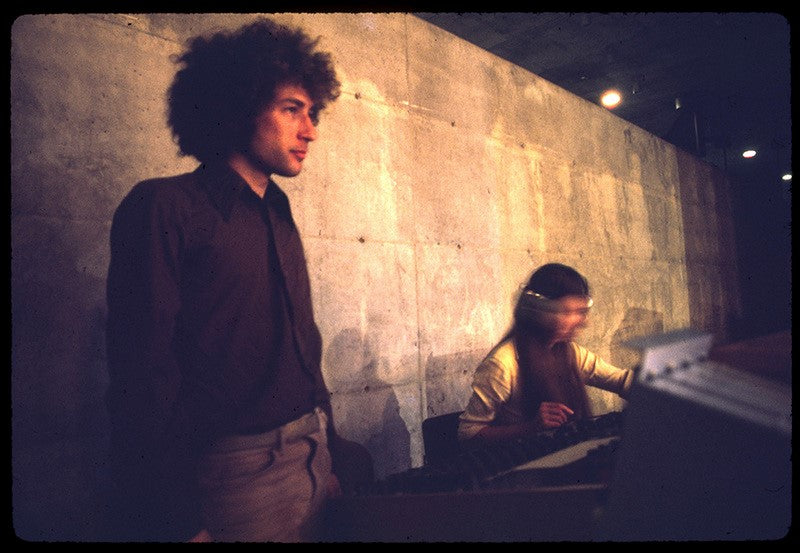
Recordists of the evening. Left to Right: Rich Gold, Maggi Payne. Photo: Pat Kelley
They say in bebop, you think in three and you play in two. And that reflects the tradition of the music of Africa. In the West, it’s 4/4 mainly, and in the East it’s 12/8 or triplets, in Motown music you can hear both of them. But having the fast triplets underneath, heard directly or just imagined, was a new thing in music. Except for jazz. And so the tension between twos and threes has gotten into our music, and it automatically provides accents that we don’t really have to emphasize, they become secondary, you know, because of what you’re feeling inside, thinking in three, playing in two.
PG: In my instrumental pieces, but also in the songs as well, I’m adding fives and sevens into that mix, so you have the 2 x 3, or the 3 x 4, but you also have five, and seven. There’s a lot of listening going on among the musicians, getting into each musical space, which also because of the nature of the different length of the different cells, sometimes takes a while for all the different permutations to come around…
NS: And to be clear, when you’re talking about fives and sevens, you not talking about quintuplets and septuplets, you’re talking about 4×5.
PG: Yeah, we’re talking about 4×5×7.
BGT: And eventually it comes out to the beginning again.
PG: So within those, there are opportunities for so many different accents -- points that come around within the cycle, and within that adding to that the layer of musicians listening to each other, so they then sort of build a whole network of musical commentary based on this. It comes out – I don’t want to say, meditative? because it’s more active than a meditative space, but it’s a more – I don’t know, a certain mindfulness. Within each one of these sections, which can last from 30 seconds to a number of minutes, even the slightest shift can change the whole landscape, that whole sense of feeling. It’s like you have a repeated gesture, and just one of the components you then shift by a 16th note, and that shifts the whole accent structure, melodic structure.
BGT: And that becomes formalized later, in dealing with rhythm in a very sophisticated way in the sense – actually, in the way that a lot of Duke Ellington arrangements dealt with it, which is, when, say, the brass comes in, and they go {snaps fingers} 1-2-3-4-5, 1-2-3-4-5, but the rest of the tune is in 4/4, and it takes them, like, 20 beats to get back to the original combination. What you’ve done is what some musicians call offset. You take the same phrase, and you offset it by an 8th note, 16th note whatever – I call it phasing – and from that, you can do a rotational rhythm idea, so that you construct two measures – dot-da-dot-da-dot / da dot da dot da -- that’s two measures, you take the da dot da dot da, the second measure, and play it when the first measure is playing, and you get this beautiful combination of what originally somebody like Stravinsky would write, very complex meter changes, you know, like in, Rite of Spring or something, which don’t have to be written that way. They can be written in straight 4/4, believe it or not. But it’s a new sense of rhythm, as in reflecting off something, physically reflecting off something, bouncing back at you. It’s like if you do a complex, say like, Cuban music or something, you have all these – each instrument plays certain kinds of riffs, or certain kinds of rhythms, then they combine them and put them all at the same time, and it’s beautiful. At the end of the long instrumental, which is called “Without Warning,” there are many, many variations that seem to change meter, but they don’t actually. They’re all internal meters of each other.
There are many ways you can formalize that feeling, but the feeling when people get together, it doesn’t necessarily need that formalization. I recently wrote a piece that used five string instruments, and some people were wondering, why five string instruments, why not a string quartet? Well, because it’s boring! And the rhythm structure came out to be just beautiful, listing to those five strings play, something I could never play, but very simple at the same time, you know, so those feelings, those things that really generate within you, can also be formalized. If you want to use it as a compositional tool you can do that also.

Paul Dresher, Steve Bartek. Photo: Pat Kelley
PG: That rhythmic offset sometimes gets misheard as an intentional stylistic reference. It’s sort of like, you know, like okay, you have the basic pulse going, you shift a component by an eighth note and it might imply a polka rhythm, or a reggae rhythm. And so just by working with these shifting offsets, it sort of goes through – how can I say, it sort of touches on what seems like different styles or genres, but really, it just enters into what that offset is. Like, you listen to some of the later Beethoven variations, where it sounds like he’s going into ragtime – and yeah, you could say he’s going into ragtime, even though this predated ragtime, but it really had to do more with dealing with those rhythmic offsets.
BGT: Also, CPE Bach sounds so much like bebop, I can hardly believe it. It’s right there, it’s a bebop rhythm, and he has, like, accenting. It’s amazing!
NS: Trust in Rock was in 1976, the post-Nixon world.
PG: November 1976, so it was right around the election of Jimmy Carter. There was a certain austerity both in punk and in minimalism, but it was also the tail end of the progressive rock era, with the multiple keyboards going on.
NS: Also, the American economy had been tanking for several years, after unbroken postwar expansion up until the 70s, and everyone was living in a new economic regime.
PG: Yeah, I had just come out of college at the time, and it seemed like everyone was scuffling.
BGT: Even though I was teaching courses at Mills College, I was being paid very little. I was working more than 60 hours a week, because I also did recording at night, and that would often be till midnight, and I would have to miss the bus and sometimes walk home to Berkeley, which took about two hours. I finally decided, no more academia. Although I really enjoyed teaching.
NS: The “rock” of Trust in Rock is a clear reference to what at the time was the dominant commercial style of popular music. But a listener hoping to hear pop music in this might find that it doesn’t move like pop music.
PG: Well, that’s where you need the trust. It’s about trust on all levels. And the idea that within, especially within that energy of early rock ‘n roll, there was a danger in it, but also the music itself provided a safety which allowed one to experience those thresholds of whatever – teenage rebellion, badness, but within a sort of controlled domestic setting.
NS: Thank you, gentlemen.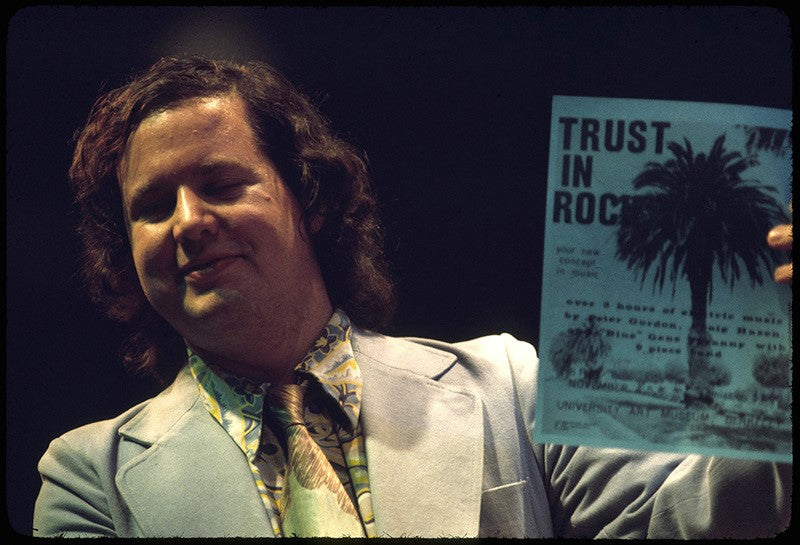









![[product title] - unseen worlds](http://unseenworlds.com/cdn/shop/products/UW18_Hi_Res_1500x.jpg?v=1566320538)
![[product title] - unseen worlds](http://unseenworlds.com/cdn/shop/products/UW018LP_1500x.jpg?v=1566320538)
![[product title] - unseen worlds](http://unseenworlds.com/cdn/shop/products/UW018CD_1500x.jpg?v=1566320538)
![[product title] - unseen worlds](http://unseenworlds.com/cdn/shop/products/UW18_Hi_Res_1445x.jpg?v=1566320538)
![[product title] - unseen worlds](http://unseenworlds.com/cdn/shop/products/UW018LP_1445x.jpg?v=1566320538)
![[product title] - unseen worlds](http://unseenworlds.com/cdn/shop/products/UW018CD_1445x.jpg?v=1566320538)
![[product title] - unseen worlds](http://unseenworlds.com/cdn/shop/products/compUW24LP-Hi-Res-2_533x.jpg?v=1566370078)
